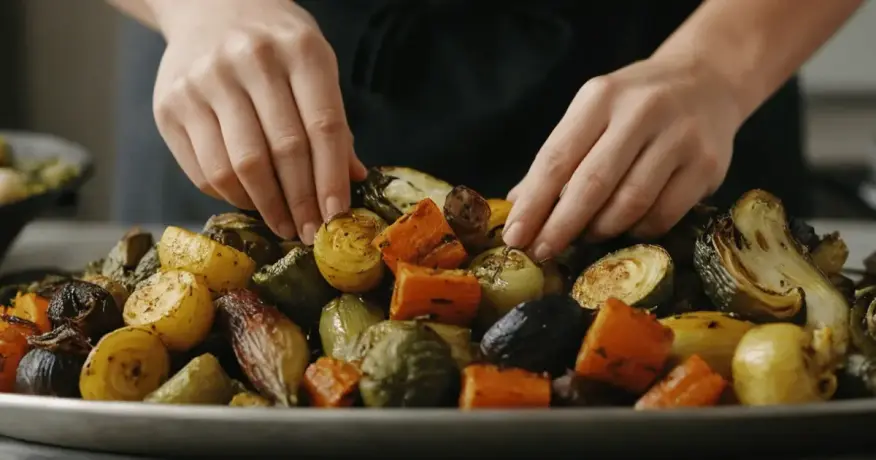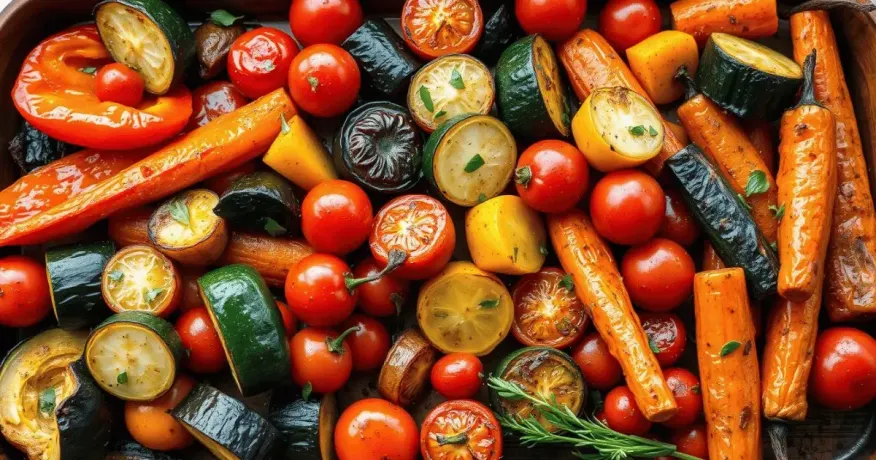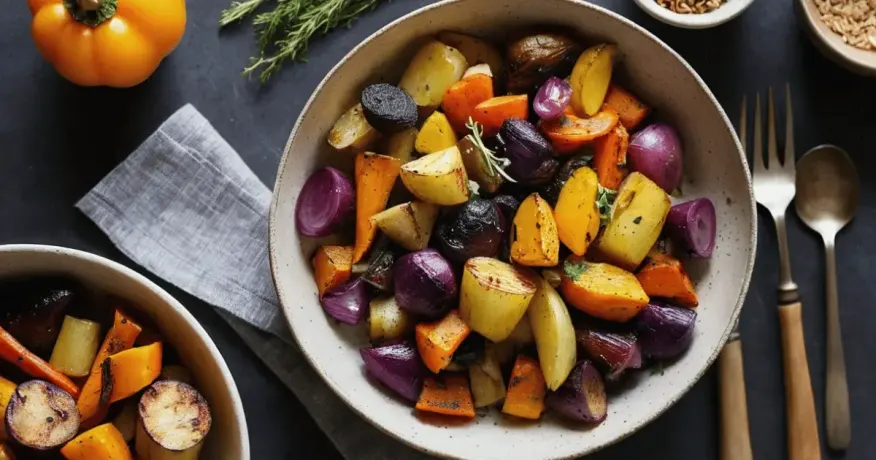
Imagine biting into a perfectly roasted carrot. Its sweetness is caramelized by the oven’s heat. The charred edges and tender inside are amazing.
Oven-roasted veggies are tasty and healthy. They’re great for any diet, including vegetarian ones.
Roasting brings out veggies’ natural flavors. High heat caramelizes their sugars, adding depth. It’s easy and fun, even for beginners.
Roasting veggies is very flexible. You can try many seasonings to make the flavors pop. Roasted veggies fit many diets, like vegan and keto.
Table of Contents
Key Takeaways
- Oven roasting is a healthy and delicious way to prepare vegetables
- Roasting enhances the natural flavors of veggies through caramelization
- This cooking method is versatile and can be adapted to various diets
- Roasted vegetables make great healthy side dishes
- Experimenting with seasonings can create exciting flavor combinations
Benefits of Oven Roasted Vegetables
Oven-roasting vegetables are easy and tasty. It makes healthy side dishes that are full of flavor. This method makes veggies sweet and crispy, making your taste buds happy.

Enhancing Natural Flavors
Roasting veggies in the oven makes them taste better. The heat caramelizes their sugars, making them sweeter. This method also makes the outside crispy and the inside soft.
To make your roasted veggies even tastier, add herbs and spices. Try these:
- Rosemary and garlic for potatoes
- Thyme and honey for carrots
- Cumin and paprika for cauliflower
- Basil and balsamic vinegar for tomatoes
Retaining Nutritional Value
Oven roasting is also very healthy. It keeps more nutrients in veggies than boiling or steaming. This method helps veggies stay full of good stuff.
Roasting veggies makes them lose water but keeps nutrients. You get more fiber, vitamins, and minerals. Plus, olive oil adds healthy fats.
| Vegetable | Key Nutrients Retained |
| Broccoli | Vitamin C, Vitamin K, Folate |
| Carrots | Beta-Carotene, Vitamin A, Biotin |
| Brussels Sprouts | Vitamin C, Vitamin K, Manganese |
| Sweet Potatoes | Vitamin A, Vitamin C, Manganese |
Choosing oven roasting for veggies makes them healthy and yummy. So, turn on the oven, pick your favorite veggies, and enjoy the tasty benefits of roasting!
Choosing the Right Vegetables for Roasting
Choosing the right vegetables is key for a tasty oven-roasted vegetable medley. Pick seasonal produce for the best taste and nutrition. Carrots, parsnips, and potatoes are great because they stay firm in the heat.
Think about the size and shape of your veggies. Cut big ones into smaller pieces for even cooking. Cherry tomatoes or Brussels sprouts can stay whole or halved, as you like.

Mixing different veggies makes your dish look good and taste great. Some favorite combos include:
| Vegetable Combination | Flavor Profile |
| Carrots, parsnips, and sweet potatoes | Sweet and earthy |
| Bell peppers, zucchini, and red onion | Colorful and aromatic |
| Broccoli, cauliflower, and garlic | Nutty and savory |
| Butternut squash, brussels sprouts, and shallots | Rich and caramelized |
For a great oven-roasted dish, use fresh, high-quality produce. Don’t pick wilted, bruised, or old veggies. They won’t roast well and can ruin your dish’s taste.
The beauty of roasting vegetables is that it brings out their natural sweetness and enhances their flavor, making even the humblest of vegetables taste delicious.
By picking seasonal produce and mixing your favorite veggies, you’ll make a delicious baked vegetable medley. It’s so good, everyone will want more.
Preparing Vegetables for Roasting
Getting your veggies ready is key for great roasted results. Follow these easy steps for easy veggie prep. This way, your veggies will be perfect for olive oil roasting and adding herbs.
Washing and Drying
First, wash your veggies under cool water. This gets rid of dirt and bad stuff. For veggies with nooks, soak them in water before rinsing.
After washing, dry them well. Use a towel or salad spinner to get rid of extra water. This helps them brown better when roasted.
Cutting and Sizing
Ensure all vegetables are cut into uniform sizes to guarantee even cooking. Avoid chopping them into overly small pieces. This way, they cook evenly.
Here’s how to cut common veggies for roasting:
| Vegetable | Cutting Technique |
| Root vegetables (carrots, parsnips, beets) | Peel (if desired) and cut into 1-inch chunks or wedges |
| Potatoes and sweet potatoes | Cut into 1-inch cubes or wedges |
| Onions and shallots | Peel and cut into wedges or 1/2-inch slices |
| Bell peppers | Remove seeds and cut into 1-inch squares |
| Zucchini and summer squash | Cut into 1/2-inch rounds or half-moons |
Seasoning and Oiling
To add flavor, toss veggies with olive oil, salt, pepper, and herbs. Use just enough oil to coat them lightly. Herb-infused vegetables come from tossing with fresh or dried herbs like rosemary or thyme.
The key to perfect roasted vegetables is cutting them into even pieces, tossing them with just the right amount of olive oil and herbs, and roasting them at a high temperature.
Follow these tips to make delicious, perfectly roasted veggies every time.
Optimal Oven Temperature and Roasting Time
To get perfectly roasted veggies, you need the right oven temperature and time. The best temperature is between 400°F and 425°F (200°C to 220°C). This heat cooks veggies fast and makes them crispy on the outside and soft inside.
The time it takes to roast veggies depends on their type and size. Here’s a guide for common veggies at 400°F (200°C):
- Root veggies (carrots, parsnips, beets): 30-45 minutes
- Cruciferous veggies (broccoli, cauliflower, Brussels sprouts): 20-30 minutes
- Squash (butternut, acorn): 30-45 minutes
- Onions and garlic: 20-30 minutes
- Peppers and zucchini: 15-20 minutes
Adjusting for Different Vegetable Types
When roasting a mix of veggies, think about their cooking times. Cut hard veggies like carrots into smaller pieces. This way, all veggies roast evenly, making a great baked vegetable medley.
If you like your veggies soft, roast at 375°F (190°C) for a bit longer. For crispy edges, try 450°F (230°C) and roast a bit less.
“The secret to perfectly roasted vegetables lies in striking the right balance between oven temperature and cooking time, tailored to the type of vegetables and your individual taste preferences.”
Oven Roasted Vegetables Seasoning Ideas
Make your oven-roasted veggies taste amazing with different seasonings. Try out classic herbs, spicy flavors, and more. You can make healthy side dishes that everyone will love.
Classic Herb Combinations
Classic herb mixes are always a hit. Mix dried oregano, basil, thyme, and rosemary for a Mediterranean taste. Or, use garlic powder, salt, and black pepper for a simple yet tasty option.

Spicy and Exotic Blends
For a spicy kick, try chili powder, cumin, smoked paprika, and cayenne pepper. Or, mix garam masala, turmeric, and coriander for an Indian flavor. These work great with cauliflower and potatoes.
Citrus and Zest Infusions
Make your veggies bright with citrus zest and juice. Grate lemon or lime zest on them or squeeze orange juice on sweet potatoes. A mix of lemon zest, garlic, and parsley adds a fresh, aromatic flavor.
Adapting Roasted Vegetables to Various Diets
Oven-roasted vegetables are tasty and fit many diets. They work for vegans, vegetarians, and those on low-carb, or keto diets. Just make a few changes to enjoy their flavors and health benefits.
Vegan and Vegetarian Options
For vegans and vegetarians, roasted veggies are perfect. Use plant-based oils like olive or coconut oil instead of butter. Also, check your seasonings for animal products, like some Worcestershire sauce.
Low-Carb and Keto-Friendly Modifications
On low-carb or keto diets, pick veggies low in carbs. Good choices are:
- Broccoli
- Cauliflower
- Zucchini
- Bell peppers
- Asparagus
- Brussels sprouts
Use healthy fats like olive oil. Season with herbs and spices without sugar or carbs. This way, you get tasty, healthy meals that fit your diet.
Serving Suggestions for Oven-Roasted Vegetables
Oven-roasted vegetables are tasty and healthy. They’re great with many dishes. They’re perfect for sheet pan meals or with your favorite proteins.
Try adding them to salads. Roasted veggies make a simple salad better. Mix roasted sweet potatoes, bell peppers, and red onions with spinach, feta cheese, and a tangy dressing.
Grain bowls are also a good choice. Use quinoa, brown rice, or farro as the base. Then add roasted veggies like Brussels sprouts, carrots, and zucchini. Add grilled chicken or tofu and a favorite dressing for a balanced meal.
Roasted veggies are also great as a side dish. They go well with grilled steak, roasted chicken, or baked fish. You can also use them in quick sheet pan meals with sausage, eggs, or cheese for breakfast or brunch.
The possibilities are endless when it comes to serving oven-roasted vegetables. Get creative and experiment with different combinations to find your favorite ways to enjoy these healthy and flavorful side dishes.
Meal Prep and Storage Tips
Roasting vegetables in the oven makes meal preparation simple and efficient. They taste good and keep well for later. Here are some suggestions to help them stay fresh for a longer time.
Let the veggies cool down before putting them in containers or bags. This stops them from getting soggy. Stored right, they last up to five days in the fridge. Perfect for meal prep.
Reheating Roasted Vegetables
There are easy ways to reheat your veggies. Spread them on a baking sheet and warm them in a 350°F oven for 5-10 minutes. Or, use a skillet or microwave for 1-2 minutes.
Incorporating into Other Dishes
Oven-roasted veggies are super versatile. Here are some ideas:
- Incorporate them into salads for added texture and flavor.
- Put them on pizzas or flatbreads
- Stir them into soups or stews
- Top grains like quinoa or rice with them
- Blend them into dips or spreads
Incorporating roasted vegetables into your meals is a healthy and flavorful choice. Try different seasonings to keep things exciting.
Seasonal Roasted Vegetable Recipes
Enjoy the taste of each season by roasting fresh vegetables. They make a tasty and healthy side dish or main course. Here are some ideas for baked vegetable medleys for spring, summer, fall, and winter.
Spring Medley
Spring brings fresh tastes with a mix of asparagus, baby carrots, spring onions, and radishes. Mix these tender veggies with olive oil, garlic, and lemon zest. Roast until crisp-tender. It’s great with grilled fish or pasta.
Summer Bounty
Summer’s abundance is celebrated with zucchini, bell peppers, eggplant, and cherry tomatoes. Cut them into similar pieces, drizzle with olive oil, and add herbs like basil and thyme. Roast until caramelized. Serve with grilled meats or as a vegetarian main with quinoa.
Fall Harvest
Fall’s hearty flavors are celebrated with butternut squash, Brussels sprouts, parsnips, and red onions. Mix with olive oil, maple syrup, and cinnamon. Roast until tender and slightly crispy. Sprinkle with toasted pumpkin seeds for crunch.
| Season | Vegetable Combination | Seasoning Suggestions |
| Spring | Asparagus, baby carrots, spring onions, radishes | Olive oil, garlic, lemon zest |
| Summer | Zucchini, bell peppers, eggplant, cherry tomatoes | Olive oil, basil, oregano, thyme |
| Fall | Butternut squash, Brussels sprouts, parsnips, red onions | Olive oil, maple syrup, cinnamon, pumpkin seeds |
| Winter | Sweet potatoes, beets, turnips, carrots | Olive oil, rosemary, sage, balsamic vinegar |
Winter Roots
Winter brings comforting flavors with sweet potatoes, beets, turnips, and carrots. Cut into wedges, toss with olive oil, and add rosemary and sage. Roast until tender and caramelized. Drizzle with balsamic vinegar for a rich finish.
No matter the season, oven-roasted vegetables are delicious and nutritious. Experiment with various vegetables and seasonings to discover your favorite combinations.
Conclusion
Roasted vegetables are both delicious and nutritious. We talked about how roasting brings out the best in veggies. It keeps them full of nutrients.
Choosing the right veggies and using different seasonings makes your dishes exciting. This way, you can make many tasty vegetarian meals.
Oven-roasted veggies work for many diets, like vegan, vegetarian, low-carb, or keto. The right oven settings make them tender and flavorful. They’re also great for meal prep, making healthy eating easy.
Try oven-roasted veggies to eat more veggies. A little creativity can lead to many delicious and healthy meals. Enjoy roasting!
FAQ
What are the benefits of oven-roasting vegetables?
Oven roasting makes veggies taste better and crispy. It keeps more nutrients than other ways of cooking. This makes them a flavorful and wholesome option for meals.
How do I choose the best vegetables for roasting?
Look for firm, even-sized veggies with great flavor. Seasonal veggies taste best and are freshest. Pick ones that can handle high heat and mix flavors and textures well.
What’s the best way to prepare vegetables for roasting?
First, wash and dry the veggies well. Cut them into similar sizes for even cooking. Season them with herbs and spices, then drizzle with olive oil for crispy edges.
What temperature should I use for roasting vegetables, and how long does it take?
Roast at 400°F to 425°F (200°C to 220°C). Cooking time is 20 to 45 minutes, depending on the veggies. Adjust heat and time for the perfect crispiness.
Can I adapt oven-roasted vegetables to fit my specific diet?
Yes, you can make roasted veggies fit many diets. Just pick veggies that fit your diet and adjust seasonings and oils as needed.
How can I incorporate oven-roasted vegetables into my meals?
Oven-roasted veggies are very flexible. Use them as a side, in salads, or as toppings. You can also blend them into soups or sauces for extra flavor.
Can I meal prep oven-roasted vegetables in advance?
Yes, they’re perfect for meal prep. Cool them down, then store them in airtight containers in the fridge. They last 3-5 days. Reheat at 350°F (175°C) for 5-10 minutes.


